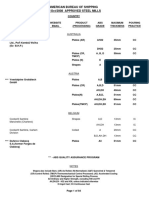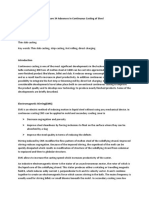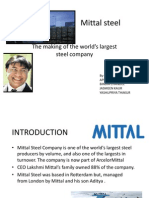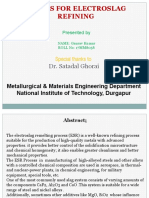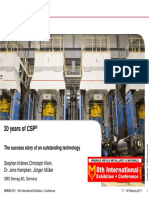Reduction of The Hydrogen Content in The Continuous Casting of Steel
Reduction of The Hydrogen Content in The Continuous Casting of Steel
Uploaded by
Brigida PaganiCopyright:
Available Formats
Reduction of The Hydrogen Content in The Continuous Casting of Steel
Reduction of The Hydrogen Content in The Continuous Casting of Steel
Uploaded by
Brigida PaganiOriginal Title
Copyright
Available Formats
Share this document
Did you find this document useful?
Is this content inappropriate?
Copyright:
Available Formats
Reduction of The Hydrogen Content in The Continuous Casting of Steel
Reduction of The Hydrogen Content in The Continuous Casting of Steel
Uploaded by
Brigida PaganiCopyright:
Available Formats
REDUCTION OF THE HYDROGEN CONTENT IN THE CONTINUOUS CASTING OF STEEL
S. R. Bragana*, J. M. Hohemberger, J. Vicenzi, C. M. Marques, T. Basegio, A. N. C. Lima, C.P. Bergmann Laboratrio de Cermicos da Universidade Federal do Rio Grande do Sul LACER/UFRGS Abstract. It is well known that the presence of dissolved hydrogen in cast steel can cause defects that appear in hot rolling and forging of steel parts with heavy sections, and also contributes to the formation of internal cracks and blowholes during the solidification of the liquid steel. These problems are especially important in the continuous casting process. So, hydrogen levels must be kept at a minimum in this process. The aim of this work is to investigate possible sources of hydrogen, focusing on the materials that are in contact with the liquid steel during casting. The tundish refractory lining, shrouding tube, tundish covering agents, and casting powders were analyzed. The results showed that not only the control of humidity content in those materials is critical, but the phase transformations that the materials suffer during the casting process are important as well.
Keywords: steel, continuous casting, hydrogen.
1. Introduction
The formation of internal cracks during hot rolling and forging of steel parts with heavy sections as a consequence of dissolved hydrogen within cast steel is know since 1930. More recently, it was realized that certain amounts of hydrogen in the liquid steel contribute to the formation of pinholes and blowholes during steel solidification, what can lead to serious problems, especially in continuous casting process (Stone, 1990). According to H. Johnson (1988), some of these problems are embrittlement, delayed fracture, stress corrosion cracking, exfoliation, and environment-assisted cracking. The damage mechanism can be attributed to the solubility behavior of hydrogen in steel, since its solubility in liquid steel is higher than in solid steel. During solidification, the trapped hydrogen can diffuse, increasing the internal pressure within the material. If the hydrogen content is high enough, this pressure can exceed the mechanical strength of the steel and cause cracks to appear. Since the formation of defects depends on the hydrogen content, it is directly related to the steel production process, part thickness and cooling conditions. Several mechanisms and sources can lead to the increase of hydrogen content during processing of liquid steel. Theoretically, hydrogen has some solubility in the slag, but it is only significant if the degassing operation (VAD) is not correctly performed. Hydrogen can be originated from refractory in two different ways: from their intrinsic humidity or from organic addictives. The possible sources of hydrogen can be summarized as follows (Lachmund, 2000; Jha, 2003; Presern, 1992):
a. b. c. d. e. f.
Environmental air (air humidity) Tundish refractory lining Pouring ceramic shrouding tube Tundish slag Casting powder or fluxes Other refractory materials used in the tundish (barriers, levees, etc).
_____________________________
*
To whom all correspondence should be addressed. Address: LACER/UFRGS Av. Osvaldo Aranha, 99/705, Porto Alegre-RS Brazil 90035-190 E-mail: saulorb@ufrgs.br
Lachmund et al. (2000) concluded that the main source of hydrogen during BOF process with continuous casting is the refractory lining and the shrouding tube, with little contribution from other sources. Therefore, preheating of the shrouding tube and control of the chemical composition of the refractory lining would be possible solutions to decrease hydrogen pick up. Care must be taken when adding materials containing free CaO in their composition, as pointed out by K.N. Jha (2003), because it easily reacts with water, according to the well know lime hydration reaction:
CaO + H2O Ca(OH)2
Hence, late additions of lime-containing materials must be avoided, and this raw material should be always kept in sealed packages. The authors explained also the capacity of water retention by the slag, which is higher when the basicity increases (because of higher amounts of CaO). In their experiments, the reduction in basicity was used as to measure the reduction in hydrogen pick up caused by the diffusion trough the metal/slag interface. In this work the objective was to evaluate the materials used in the tundish of steel continuous casting in a local company. They produce high alloy steels from scrap, which is melted in EAF oven and vacuum degassed (VAD). The probable hydrogen sources were analyzed, aiming to generate useful information that could be used to minimize hydrogen absorption within the steel, changing procedures and/or materials. In order to achieve that, the hydrogen content in steel was measured at different process steps, in such a way that it was possible to identify in which step the increase in hydrogen is higher. After that, the refractories were evaluated by means of thermal analysis techniques, and the gases released by the tundish refractories, because of heating, were simultaneously analyzed.
2. Experimental Procedure and Materials
The hydrogen content in steel was measured by a Hydris probe, trying to control the evolution of the hydrogen content after the degassing step. The hydrogen contents in the tundish were referenced to the values initially measured in the ladle. From the obtained results, the materials that had contact with the steel and could provide H2 to it during continuous casting were analyzed. The materials from the tundish that were analyzed were the concretes used as wearing coating (obtained both by dry and wet molding), the permanent concrete (coated by the wearing concrete), the shrouding tube, and the fluxes. The wet molded wearing refractory, denoted by JM, contains magnesium, and it is deposited by gunning process. The paste is prepared with water additions of 25 % to the refractory concrete. The dry wearing concrete, denoted by DM, also contains magnesium in its composition. Both are deposited over the permanent concrete until a maximum thickness of 35 mm is reached. The shrouding tube is composed mainly by alumina, while the permanent concrete contains silicon and alumina. The flux used in the process is added when the volume of steel in the tundish reaches about 50% of the tundish volume; hence, any hydrogen or humidity that can be released from this material is critical to the process.
The mineralogical composition of these materials was determined by means of X ray diffraction. Differential thermal analyses with simultaneous analyses of the gases (H2, H2O, CO2) were also conducted.
3. Results
3.1 Hydrogen content measurements Figure 1 shows the hydrogen contents in steel, measured in ladle and tundish. For comparison reasons, measurements were taken in the ladle at different moments of its first run. The graph shows that the hydrogen content is higher in the tundish when compared to the ladle. Such difference is more significant for steel poured in the tundish at the first stage of the run. In this case, the tundish was just assembled and came from right after pre-heating. This was, hence, its first run, with new lining and fresh slag. Considering mean values, the hydrogen pick up at the tundish in relation to the ladle is about 1.2 ppm. At the end of the pouring process, the hydrogen content is only 0.5 ppm higher than the initial value at the ladle. Therefore, it can be inferred that the tundish materials are hydrogen sources, contributing to a higher hydrogen pick up in the steel when compared to the steel in the ladle.
Fig. 1. Hydrogen contents in steel in ladle and tundish, considering a new tundish (first run after assembly).
3.2 Drying and Heating Figure 2 shows the results obtained from temperature measurements made by two thermocouples that were inserted into the wearing refractory, according to the scheme showed in Figure 3. Two heating steps occur in the tundish. At the first one, drying (removal of molding water) and cure of the resins, which are used to bond the particles, are carried out. At this initial stage the temperature measured at about 10 mm inside the refractory almost reach 100C, which would be high enough to remove water from surface pores. At the second step, when the tundish is heated up before steel pouring, the results showed that the temperatures that are reached are insufficient to the complete removal of the structural water, since these temperatures oscillated between 260C to 450C. The differences observed between the thermocouples can be attributed to the differences in the distance
from the gas burner used for heating, and to some variations in refractory thickness where the thermocouples were inserted as well. In this case, both factors contribute to a higher temperature measured by thermocouple 1. From these observations, it can be concluded that these materials can cause an increase in steel hydrogen content.
Fig. 2. Drying (D) at 300C (flame temperature) and heating (H) at 1100C (flame temperature). Thermocouples T1 and T2 inserted 10 mm into the refractory.
Fig. 3. Location of the thermocouples used to measure temperatures during tundish drying and heating.
3.3 Materials Characterization and Evaluation of the Gases Released from Tundish Refractory. The results of thermal analysis (thermogravimetry and differential thermal analysis), as well as the analysis of the gases (H2, H2O, CO2), of refractory materials, shrouding tube e fluxes present in the tundish are shown in Figures 4, 5, and 6.
Fig. 4. Simultaneous thermal analysis (DTA and TG) and analysis of the gases released at the heating of the wearing lining DM.
Fig. 5. Simultaneous thermal analysis (DTA and TG) and analysis of the gases released at the heating of the wearing lining JM.
Fig. 6. Simultaneous thermal analysis (DTA and TG) and analysis of the gases released at the heating of the fluxes.
Considering all analyzed materials, only the wearing refractory and the flux showed a peak of water and/or hydrogen release. The highest hydrogen content was found in the flux, which would potentially contribute to a higher absorption of hydrogen by the steel. The weight loss peak and the endothermic peak within the temperature range of 400C and 500C can be observed in the graphs showed in Figure 6. This temperature range would be characteristic of the decomposition of substances accompanied by structural water releasing. To confirm such hypothesis, the mineralogical composition of the flux was analyzed, as can be seen in Figure 7.
Fig. 7. Powder XRD curve of tundish slag compounds (flux), showing the presence of calcium compounds, including a hydrated phase: Ca(OH)2.
Based on these investigations and on the obtained results, it can be inferred that the flux contains compounds (as showed in Figure 7) that lead to releasing of H2O and H2 during its heating until a temperature of about 560C (Figure 6). Therefore, the flux can potentially contribute to the increase in the hydrogen content in steel, since it is added in the tundish just before the beginning of the continuous casting process.
4. Conclusions
The results obtained from the characterization of the materials involved in the continuous casting process showed that the permanent refractories and the shrouding tube have little contribution to the H2 absorption by the steel. The wearing refractories, however, can release hydrogen; so, control of the drying and heating process is recommendable in order to guarantee total elimination of the H2O/H2 sources. The used flux had great H2 releasing potential, since it is composed by hydrated phases that are decomposed during heating, releasing water. The estimated water content in the flux is about 8 %. Since the amount of flux added in the process is about 120 kg, it could release up to 9.6 kg of H2O. This result explains the increase of hydrogen content in steel in the tundish, and it is confirmed by the increase in the hydrogen content in the first runs and its decrease in subsequent runs. In the later ones, the flux would be calcined and inert regarding to hydrogen release.
References
Jha, K.N., Sardar, M.K., Chakraborty, N.N S. (2003). Hydrogen control during steel making for medium carbon wheels, Scandinavan Journal of Metallurgy, 32. Johnson, H. (1988). Hydrogen in iron. Metall. Transc. B, v. 19, 10. Lachmund, H., Schwinn, V., Jungblunt, A. (2000). Heavy plate production: demand on hydrogen control, Ironmaking and Steelmaking, 27, 5. Presern, V. (1992). Recent trends and the future of vacuum in steel making, Vacuum, 43, 5-7. Stone, R. P., Plessers, J., Turkdogan, E. T. (1990). Accuracy of Determining Hydrogen Content of Liquid Steel with the Hydris System. German chem. Con..
You might also like
- The Changing Global Landscape For The 21st Century Teachers - PPPDocument20 pagesThe Changing Global Landscape For The 21st Century Teachers - PPPJhosua Laoang86% (29)
- The Working of Steel: Annealing, Heat Treating and Hardening of Carbon and Alloy SteelFrom EverandThe Working of Steel: Annealing, Heat Treating and Hardening of Carbon and Alloy SteelNo ratings yet
- Centrifugal Shroud Tundish SteelmakingDocument12 pagesCentrifugal Shroud Tundish Steelmakingdebasish chatterjeeNo ratings yet
- Defects of The Steel Billet in Continuous Casting: Anh-Hoa BUI and Van-Hung NGUYENDocument6 pagesDefects of The Steel Billet in Continuous Casting: Anh-Hoa BUI and Van-Hung NGUYENafzalNo ratings yet
- Tempcore ProcessDocument23 pagesTempcore ProcessKumaran 1987No ratings yet
- Project On "Caster Slab Dimensional Accuracy Technique"Document16 pagesProject On "Caster Slab Dimensional Accuracy Technique"Mayur ParvaniNo ratings yet
- Determination of Inclusions in Liquid Steel After Calcium TreatmentDocument4 pagesDetermination of Inclusions in Liquid Steel After Calcium TreatmentWendel De Carvalho TôrresNo ratings yet
- Billet Defects: Pinhole and Blowhole Formation, Prevention and EvolutionDocument11 pagesBillet Defects: Pinhole and Blowhole Formation, Prevention and EvolutionAbdelraouf ZaidNo ratings yet
- Basic Oxygen ProcessDocument25 pagesBasic Oxygen ProcessSamanway DasNo ratings yet
- Metallurgy of Carbon SteelDocument6 pagesMetallurgy of Carbon SteelzidaaanNo ratings yet
- Aisi 305Document3 pagesAisi 305Aditya PratapNo ratings yet
- Fluid Flow in Tundish PDFDocument73 pagesFluid Flow in Tundish PDFPrakash SarangiNo ratings yet
- Scarfing Steel Slabs TechniqueDocument9 pagesScarfing Steel Slabs TechniquecamableNo ratings yet
- ABS Approved Still Mill PDFDocument84 pagesABS Approved Still Mill PDFJanuar Target Willyam0% (1)
- CONTINUOUS CASTING ColloquiumDocument18 pagesCONTINUOUS CASTING ColloquiumakritiNo ratings yet
- Embr 1 PDFDocument32 pagesEmbr 1 PDFKamod RanjanNo ratings yet
- CCM TrainingDocument14 pagesCCM TrainingAshutosh SinghNo ratings yet
- Continuous Casting of Aluminum Based Bearing Alloys Subs Tech)Document5 pagesContinuous Casting of Aluminum Based Bearing Alloys Subs Tech)Carlos LorenzanaNo ratings yet
- 4 AodDocument5 pages4 AodSonu MishraNo ratings yet
- 6-CC 2011-India-Mg-recoverDocument21 pages6-CC 2011-India-Mg-recovercrazy dNo ratings yet
- Alternative To Fluorspar As A Fluxing Agent in Ladle Furnace During Secondary Steel Refining ProcessDocument54 pagesAlternative To Fluorspar As A Fluxing Agent in Ladle Furnace During Secondary Steel Refining ProcessPrashant ChoudharyNo ratings yet
- Advances in Continuous Casting PDFDocument4 pagesAdvances in Continuous Casting PDFPrakash SarangiNo ratings yet
- Effect of Niobium On The As-Cast Microstructure of Hypereutectic High Chromium Cast IronDocument4 pagesEffect of Niobium On The As-Cast Microstructure of Hypereutectic High Chromium Cast IronMatheus BoligonNo ratings yet
- New Era in SteelmakingDocument6 pagesNew Era in SteelmakingjtpmlNo ratings yet
- MCM AllDocument7 pagesMCM AllPalanisamy RajaNo ratings yet
- Continuous Roll Casting of AluminiumDocument4 pagesContinuous Roll Casting of AluminiumLuis HernandezNo ratings yet
- Strip CastingDocument38 pagesStrip CastingRAULYEPEZSANCHEZNo ratings yet
- Etchant Test On CastingsDocument2 pagesEtchant Test On CastingsHarshaVeeragandhamNo ratings yet
- InclusionsDocument40 pagesInclusionsricha_msmeNo ratings yet
- AMCOL - MCST - TR - HeviSand - Chromite - Double - Skin Defect - On - Heavy - Steel - Casting PDFDocument12 pagesAMCOL - MCST - TR - HeviSand - Chromite - Double - Skin Defect - On - Heavy - Steel - Casting PDFSUNDRAMNAGANo ratings yet
- Slag ItroductionDocument45 pagesSlag ItroductionkidcatNo ratings yet
- ATAS Dynamic InoculationDocument27 pagesATAS Dynamic InoculationRaymundodelCampoNo ratings yet
- 7B-4 Charging HM in EAF's - Reducing Cost PDFDocument16 pages7B-4 Charging HM in EAF's - Reducing Cost PDFChristiani Hera TangkealloNo ratings yet
- Mittal SteelDocument25 pagesMittal SteelApra BishtNo ratings yet
- Carbon Pick-Up IF Steels PDFDocument3 pagesCarbon Pick-Up IF Steels PDFAnonymous jYdzzw6No ratings yet
- Energy Optimization at EafDocument32 pagesEnergy Optimization at Eafmetudgn100% (1)
- General Principles and Process of Isolation of ElementDocument3 pagesGeneral Principles and Process of Isolation of ElementAjay WaliaNo ratings yet
- Texture Evolution in Grain-Oriented Electrical Steel During Hot Band Annealing and Cold RollingDocument10 pagesTexture Evolution in Grain-Oriented Electrical Steel During Hot Band Annealing and Cold Rollingد. علا محمد حداويNo ratings yet
- Investment CastingDocument8 pagesInvestment Castingbandit96No ratings yet
- Table For Density of MetalDocument3 pagesTable For Density of Metalmtarunkumar100% (1)
- Steel: Definition, Methods, ProcessesDocument78 pagesSteel: Definition, Methods, ProcessesEsmeralda Carmela Violet EvergardenNo ratings yet
- Fluxes For Electroslag Refining: Dr. Satadal GhoraiDocument21 pagesFluxes For Electroslag Refining: Dr. Satadal GhoraiGarry's GamingNo ratings yet
- 20 Yrs of CSP Technology PDFDocument27 pages20 Yrs of CSP Technology PDFBhoomaiah SunkenapalliNo ratings yet
- The TEMPCORE ProcessDocument15 pagesThe TEMPCORE ProcessShanna Lee100% (1)
- Progress of Emission Control System in EAF ShopsDocument8 pagesProgress of Emission Control System in EAF ShopsJoão CoelhoNo ratings yet
- Development of New Model of Mold Oscillator in Continuous CastingDocument5 pagesDevelopment of New Model of Mold Oscillator in Continuous CastingM M HossainNo ratings yet
- Solidification Analysis in Continuous Casting Process - Barman TambunanDocument11 pagesSolidification Analysis in Continuous Casting Process - Barman TambunanBarman TambunanNo ratings yet
- Studying The Effect of Tramp Elements inDocument7 pagesStudying The Effect of Tramp Elements inmohit madaviNo ratings yet
- Slide Gate System DevelopmentDocument14 pagesSlide Gate System DevelopmentA.S.M. Mosayeb RafiNo ratings yet
- Cif Purge Plug Systems en 3Document3 pagesCif Purge Plug Systems en 3abdeljalil elbadrNo ratings yet
- Casting Flux PDFDocument6 pagesCasting Flux PDFBiju KNo ratings yet
- Aluminizing by (08MT3012 & 08MT1030) Atanu & ManojDocument24 pagesAluminizing by (08MT3012 & 08MT1030) Atanu & ManojAtanu KumarNo ratings yet
- Synthetic Slag For Secondary SteelmakingDocument6 pagesSynthetic Slag For Secondary SteelmakingWaqas Ahmed100% (2)
- BFDocument56 pagesBFvikrantsingh2908No ratings yet
- 8 Investment Casting ProcessDocument2 pages8 Investment Casting ProcessFahri RamadhanNo ratings yet
- TALAT Lecture 3207: Solidification Defects in CastingsDocument29 pagesTALAT Lecture 3207: Solidification Defects in CastingsCORE Materials100% (1)
- Dycote : ManualDocument30 pagesDycote : ManualG Alex QSNo ratings yet
- Present Indian Steel Making Practice and Its Scenario: Introduction: WHAT IS STEEL?Document10 pagesPresent Indian Steel Making Practice and Its Scenario: Introduction: WHAT IS STEEL?SarbajitManna100% (1)
- A Bell-Type Annealing Furnac PDFDocument9 pagesA Bell-Type Annealing Furnac PDFfercho-kun satochiNo ratings yet
- Mechanical Properties Enhancement of Al-Si (Adc12) Alloy by Heat TreatmentDocument5 pagesMechanical Properties Enhancement of Al-Si (Adc12) Alloy by Heat Treatmentsatheez3251No ratings yet
- 20Document55 pages20José Arlindo FrancoNo ratings yet
- Yuxuan Full PLLDocument4 pagesYuxuan Full PLLRichy UdilNo ratings yet
- Suraj Estate Developers LTD 638383298341101394Document6 pagesSuraj Estate Developers LTD 638383298341101394pranavgawade10No ratings yet
- Plant ProtectionDocument9 pagesPlant ProtectionPooja BhusalNo ratings yet
- Trade ServicesDocument7 pagesTrade ServicesSusmita JakkinapalliNo ratings yet
- IWC Catalogue 2014 - 2015Document310 pagesIWC Catalogue 2014 - 2015Simon László50% (2)
- Roadmap On Adoption of BUILDING INFORMATION MODELLING For Building Plan Preparation and SubmissionDocument36 pagesRoadmap On Adoption of BUILDING INFORMATION MODELLING For Building Plan Preparation and SubmissionSAKHUMZINo ratings yet
- Concord Servicing Corporation Hires Veteran Loan Servicing Business Development SpecialistDocument4 pagesConcord Servicing Corporation Hires Veteran Loan Servicing Business Development SpecialistPR.comNo ratings yet
- Outcomes. Pre-Intermediate - Student's Book, 2ndDocument270 pagesOutcomes. Pre-Intermediate - Student's Book, 2ndLoan Nguyễn ThanhNo ratings yet
- Neopentyl Glycol Flakes: Safety Data SheetDocument8 pagesNeopentyl Glycol Flakes: Safety Data SheetsirajNo ratings yet
- Battery Eliminator CircuitDocument5 pagesBattery Eliminator CircuitGiriNo ratings yet
- Cambridge IGCSE: Global Perspectives 0457/13Document12 pagesCambridge IGCSE: Global Perspectives 0457/13Vinayak KapoorNo ratings yet
- Character-Integrated Lesson PlanDocument1 pageCharacter-Integrated Lesson PlanChristopher Martin GunsatNo ratings yet
- From Powders To Thermally Sprayed CoatingsDocument25 pagesFrom Powders To Thermally Sprayed CoatingsRoberson SilvaNo ratings yet
- Consolidation Exercises With AsnwerDocument47 pagesConsolidation Exercises With Asnwerjessica amoroso100% (1)
- IB Biology IA Previously Submitted (Level 7)Document11 pagesIB Biology IA Previously Submitted (Level 7)Mazaruni KhanNo ratings yet
- Fnaf Wall - Szukaj W GoogleDocument1 pageFnaf Wall - Szukaj W GoogleciemnagabrysiaNo ratings yet
- 10 Scientifically Impossible Places That Actually ExistDocument10 pages10 Scientifically Impossible Places That Actually ExistShahid Aziz0% (1)
- Ausschreibung Iccs Young Talents 2023 EngDocument2 pagesAusschreibung Iccs Young Talents 2023 EngMLNo ratings yet
- História / DaguerreótipoDocument7 pagesHistória / DaguerreótipoMaurício ZoueinNo ratings yet
- STD Viii PSG 2Document14 pagesSTD Viii PSG 2Md. Masroor-ul AlamNo ratings yet
- 2014 Black Rhino EAZA Best Practice Guidelines ApprovedDocument85 pages2014 Black Rhino EAZA Best Practice Guidelines ApprovedGergely Sandor NagyNo ratings yet
- Weirdo #02Document36 pagesWeirdo #02pedroNo ratings yet
- The Freshman: Buffy Angel ShowDocument42 pagesThe Freshman: Buffy Angel ShowSupremeMugwumpNo ratings yet
- Week 8Document17 pagesWeek 8HikariMujiNo ratings yet
- Lab1 HandoutDocument62 pagesLab1 HandoutBERKAY GÖNÜLAÇARNo ratings yet
- The World For Sick Proper: Kweku (9), Accra, GhanaDocument5 pagesThe World For Sick Proper: Kweku (9), Accra, GhanagersonNo ratings yet
- Tgs Bhs InggrisDocument2 pagesTgs Bhs InggrisFitri melaniNo ratings yet
- IPO ProcessDocument27 pagesIPO ProcessCA VK AsawaNo ratings yet
- Dan-Resume-Aug-2021 1Document1 pageDan-Resume-Aug-2021 1api-337913388No ratings yet













